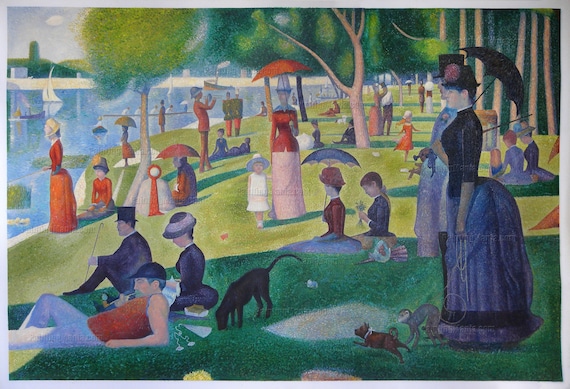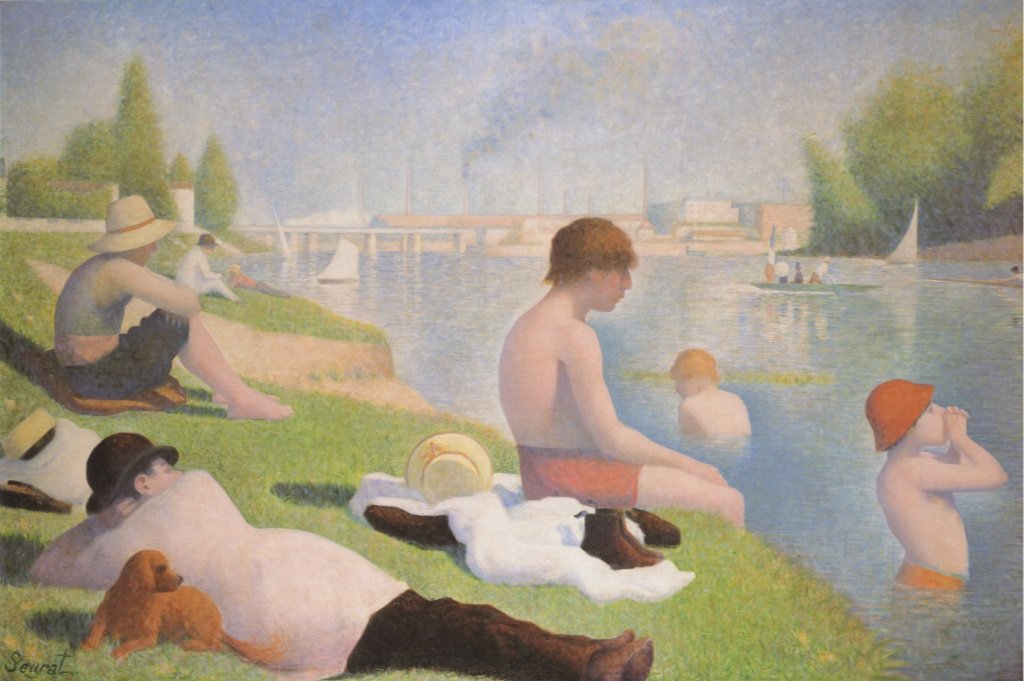George Seurat’s painting, A Sunday Afternoon on the Island of La Grande Jatte, remains one of the most celebrated artworks in the history of Western art. Completed between 1884 and 1886, this piece exemplifies the pointillism technique, employing small dots of color to create a vivid and harmonious scene. Set against the backdrop of the Seine River, the painting captures a leisurely day in Paris, showcasing a diverse spectrum of people engaging in various recreational activities.
Art historians and enthusiasts continue to regard this masterpiece as both an innovative work of art and a cultural snapshot of late 19th-century French society. This article explores the historical context of the painting, its artistic techniques, and its lasting impact on contemporary art and culture.
What is A Sunday Afternoon on the Island of La Grande Jatte about?
A Sunday Afternoon on the Island of La Grande Jatte depicts a serene afternoon on a small island in the Seine, where people from different social classes gather to enjoy leisure time. The scene features men, women, and children engaging in activities such as strolling, picnicking, and relaxing by the water. Seurat’s meticulous arrangement of figures and use of color create a sense of order and tranquility, inviting viewers to immerse themselves in this idyllic moment.
The Historical Context of the Painting
Completed during a period of significant change in France, A Sunday Afternoon on the Island of La Grande Jatte reflects the societal shifts brought about by the Industrial Revolution. The 1880s saw Paris transform into a bustling metropolis, altering the fabric of urban life. Many Parisians escaped the pressures of city life by visiting parks and recreational areas, particularly those along the Seine.
During this time, the rise of Impressionism also influenced Seurat. While Impressionists focused on capturing fleeting moments and the effects of light, Seurat sought to establish a more systematic approach to painting through his technique of pointillism, which involved applying small, distinct dots of color to build up images. His method aimed to achieve a greater sense of luminosity and vibrancy, which distinguishes his work from that of his contemporaries.
Artistic Techniques: Pointillism and Beyond
The technique Seurat used in A Sunday Afternoon on the Island of La Grande Jatte demonstrates his innovative approach to color and form. Pointillism involves placing small dots of pure color side by side on the canvas, allowing the viewer’s eye to blend them optically rather than physically mixing pigments. This technique not only enhances the vibrancy of the colors but also creates a dynamic interplay of light and shadow.
This method stands in stark contrast to traditional painting, which relied on brushstrokes and blending techniques. Seurat meticulously planned his composition, making preliminary sketches to arrange the figures in a structured yet lively manner.
Key Features of Pointillism
| Feature | Description |
|---|---|
| Color Theory | Uses complementary colors to create visual harmony. |
| Optical Mixing | Viewers perceive blended colors from a distance. |
| Structured Composition | Planned arrangement of figures for balance and movement. |
Seurat’s choice of colors also played a significant role in conveying emotion and atmosphere. By utilizing a limited palette enriched with vibrant hues, he created a scene that feels both tranquil and inviting. The meticulous application of color and light in combination with the idyllic setting allows viewers to experience the essence of a leisurely Sunday afternoon.

The Cultural Impact of Seurat’s Masterpiece
A Sunday Afternoon on the Island of La Grande Jatte transcends its time and continues to inspire modern artists and art enthusiasts. Its influence extends across various artistic movements, including Neo-Impressionism and the broader spectrum of modern art. Artists such as Vincent van Gogh and Henri Matisse drew inspiration from Seurat’s techniques and ideas, integrating aspects of his vision into their own works.
The painting exemplifies the shift toward abstraction that characterized much of 20th-century art. It encourages viewers to consider the relationship between color, perception, and experience. As contemporary artists experiment with form and color, Seurat’s work serves as a enduring point of reference, challenging creators to evaluate how they engage with their medium.
Public Reception and Legacy
Initially, A Sunday Afternoon on the Island of La Grande Jatte received mixed reviews. While some critics appreciated its innovative approach, others found the technique cold and alienating. Over time, however, the painting has become a hallmark of Western art, lauded not only for its technical prowess but also for its social commentary on leisure and community life in a rapidly changing society.
Today, the painting resides in the Art Institute of Chicago, attracting thousands of visitors annually. Its status as a vital work of art cements Seurat’s legacy as one of the most important figures in the history of modern art.
Visitor Statistics at the Art Institute of Chicago
| Year | Visitors | Notable Events |
|---|---|---|
| 2020 | 1,200,000 | Virtual exhibitions due to COVID-19 |
| 2021 | 2,500,000 | Reopening and special events |
| 2022 | 3,000,000 | Anniversary of Seurat’s painting |
Conclusion
A Sunday Afternoon on the Island of La Grande Jatte encapsulates a pivotal moment in art history, merging technical innovation with rich cultural commentary. George Seurat’s pioneering techniques continue to resonate with artists and art lovers alike, reminding us of the profound impact art can have on society. The painting not only reflects an era but also prompts ongoing discussions about leisure, social structures, and the role of art in capturing the human experience. As we admire Seurat’s work, we find ourselves transported to a serene afternoon in Paris, inviting us to reflect on our own moments of relaxation and joy.

